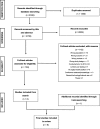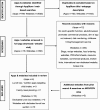A systematic evaluation of digital nutrition promotion websites and apps for supporting parents to influence children's nutrition
- PMID: 32041640
- PMCID: PMC7011240
- DOI: 10.1186/s12966-020-0915-1
A systematic evaluation of digital nutrition promotion websites and apps for supporting parents to influence children's nutrition
Abstract
Background: Globally children's diet quality is poor. Parents are primary gatekeepers to children's food intake; however, reaching and engaging parents in nutrition promotion can be challenging. With growth in internet and smartphone use, digital platforms provide potential to disseminate information rapidly to many people. The objectives of this review were to conduct a comprehensive and systematic evaluation of nutrition promotion via websites and apps supporting parents to influence children's nutrition, from three different perspectives: 1) current evidence base, 2) end user (parent) experience and 3) current commercial offerings.
Methods: Three systematic reviews were undertaken of (1) studies evaluating the effectiveness for digital platforms for improving nutrition in children and parents, (2) studies conducting user-testing of digital tools with parents, (3) websites and apps providing lunch-provision information to parents. Searches were conducted in five databases for reviews one and two, and systematic search of Google and App Store for review three. Randomised controlled trials, cohort and cross-sectional and qualitative studies (study two only) were included if published in English, from 2013, with the intervention targeted at parents and at least 50% of intervention content focused on nutrition. Search results were double screened, with data extracted into standardised spreadsheets and quality appraisal of included search results.
Results: Studies evaluating digital nutrition interventions targeting parents (n = 11) demonstrated effectiveness for improving nutrition outcomes, self-efficacy and knowledge. Six of the included randomised controlled trials reported digital interventions to be equal to, or better than comparison groups. User-testing studies (n = 9) identified that digital platforms should include both informative content and interactive features. Parents wanted evidence-based information from credible sources, practical tools, engaging content and connection with other users and health professionals. Websites targeting lunch provision (n = 15) were developed primarily by credible sources and included information-based content consistent with dietary guidelines and limited interactive features. Lunchbox apps (n = 6), developed mostly by commercial organisations, were more interactive but provided less credible information.
Conclusions: Digital nutrition promotion interventions targeting parents can be effective for improving nutrition-related outcomes in children and parents. As demonstrated from the lunchbox context and user-testing with parents, they need to go beyond just providing information about positive dietary changes, to include the user-desired features supporting interactivity and personalisation.
Keywords: Child food intake; Digital; Lunchbox; Mobile applications; Nutrition; Parents; Website; eHealth; mHealth.
Conflict of interest statement
DZ, CM, GM, LM and RG declare that they have no competing interests. WW, JD and AD are employed by Cancer Council New South Wales (NSW), the funding body which commissioned this review. Cancer Council NSW authors the ‘Healthy Lunch Box’ website, which was included in objective 3 search results.
Figures
Similar articles
-
Planting Seeds for the Future: Scoping Review of Child Health Promotion Apps for Parents.JMIR Mhealth Uhealth. 2023 Jul 20;11:e39929. doi: 10.2196/39929. JMIR Mhealth Uhealth. 2023. PMID: 37471125 Free PMC article.
-
Mobile- and Web-Based Interventions for Promoting Healthy Diets, Preventing Obesity, and Improving Health Behaviors in Children and Adolescents: Systematic Review of Randomized Controlled Trials.J Med Internet Res. 2025 May 20;27:e60602. doi: 10.2196/60602. J Med Internet Res. 2025. PMID: 40392587 Free PMC article.
-
Perspectives and Preferences of Adult Smartphone Users Regarding Nutrition and Diet Apps: Web-Based Survey Study.JMIR Mhealth Uhealth. 2021 Jul 30;9(7):e27885. doi: 10.2196/27885. JMIR Mhealth Uhealth. 2021. PMID: 34328425 Free PMC article.
-
Apps to improve diet, physical activity and sedentary behaviour in children and adolescents: a review of quality, features and behaviour change techniques.Int J Behav Nutr Phys Act. 2017 Jun 24;14(1):83. doi: 10.1186/s12966-017-0538-3. Int J Behav Nutr Phys Act. 2017. PMID: 28646889 Free PMC article.
-
Infant Feeding Websites and Apps: A Systematic Assessment of Quality and Content.Interact J Med Res. 2015 Sep 29;4(3):e18. doi: 10.2196/ijmr.4323. Interact J Med Res. 2015. PMID: 26420339 Free PMC article.
Cited by
-
Interactive Malaysian Childhood Healthy Lifestyle (i-MaCHeL) programme: a single-arm pilot study.Pilot Feasibility Stud. 2024 May 18;10(1):80. doi: 10.1186/s40814-024-01483-7. Pilot Feasibility Stud. 2024. PMID: 38762727 Free PMC article.
-
The level of wasting and associated factors among children aged 6-59 months in sub-Saharan African countries: multilevel ordinal logistic regression analysis.Front Nutr. 2024 Jun 6;11:1336864. doi: 10.3389/fnut.2024.1336864. eCollection 2024. Front Nutr. 2024. PMID: 38903623 Free PMC article.
-
Parents' Experiences Using Digital Health Technologies in Paediatric Overweight and Obesity Support: An Integrative Review.Int J Environ Res Public Health. 2022 Dec 27;20(1):410. doi: 10.3390/ijerph20010410. Int J Environ Res Public Health. 2022. PMID: 36612733 Free PMC article.
-
Parents' mHealth App for Promoting Healthy Eating Behaviors in Children: Feasibility, Acceptability, and Pilot Study.J Med Syst. 2022 Sep 16;46(11):70. doi: 10.1007/s10916-022-01860-w. J Med Syst. 2022. PMID: 36109423
-
An mHealth Intervention to Reduce the Packing of Discretionary Foods in Children's Lunch Boxes in Early Childhood Education and Care Services: Cluster Randomized Controlled Trial.J Med Internet Res. 2022 Mar 17;24(3):e27760. doi: 10.2196/27760. J Med Internet Res. 2022. PMID: 35297768 Free PMC article. Clinical Trial.
References
Publication types
MeSH terms
LinkOut - more resources
Full Text Sources
Research Materials




